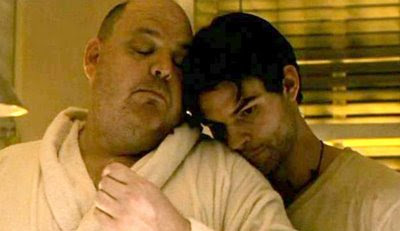Daddy's Back in The Stepfather Remake
 Sony pictures is coming out with a remake of the original 1987 slasher The Stepfather, starring Dylan Walsh from Nip/Tuck as the shady father figure David Harris and Sela Hardin as Susan Harding, the single mother of three who marries him.
Sony pictures is coming out with a remake of the original 1987 slasher The Stepfather, starring Dylan Walsh from Nip/Tuck as the shady father figure David Harris and Sela Hardin as Susan Harding, the single mother of three who marries him.Their family is picture perfect as David takes the kids to movies, the arcade and and still has enough time left over to shower his new wife with affection. But Susan's teenage son Michael begins to suspect that his stepfather isn't what he seems when their elderly next door neighbor thinks she recognizes him from an episode of America's Most Wanted.
 Michael does some web research and finds out the killer featured on AMW is wanted in the slaying of an entire family. As it turns out David is the killer and his modis operandi is searching for the perfect family by marrying single women with kids. But when that family doesn't live up to his expectations, he disposes of them and moves on to the next target. Things start to fall apart as David realizes his current family isn't a carbon copy of the clan from Leave it to Beaver.
Michael does some web research and finds out the killer featured on AMW is wanted in the slaying of an entire family. As it turns out David is the killer and his modis operandi is searching for the perfect family by marrying single women with kids. But when that family doesn't live up to his expectations, he disposes of them and moves on to the next target. Things start to fall apart as David realizes his current family isn't a carbon copy of the clan from Leave it to Beaver.The original Stepfather was a slasher film that managed to offer a progressive reading for women, quite a feat considering the gender bias built into the formula, as evidenced by Rita Mae Brown's failed attempt at a feminist slasher with Slumber Party Massacre.
 In the original Terry O' Quinn plays Jerry Blake, a real estate agent with a nasty habit for familicide. He has just killed his most recent family a year before and has moved on to greener pastures when he meets a widower named Susan. They hit it off and decide to get married, much to the dismay of Susan's daughter Stephanie who thinks there is something off about her new stepdad.
In the original Terry O' Quinn plays Jerry Blake, a real estate agent with a nasty habit for familicide. He has just killed his most recent family a year before and has moved on to greener pastures when he meets a widower named Susan. They hit it off and decide to get married, much to the dismay of Susan's daughter Stephanie who thinks there is something off about her new stepdad.In the film Jerry represents an oppressive patriarchal figure who attempts to keep the women in his family under control. He completely loses it when he spies Stephanie making out with her boyfriend, as her outward expression of sexuality threatens his entire world of power and control. It's then that he decides this family isn't perfect enough for him and he begins to create a new identity for himself and starts to date another woman.
 When Susan and Stephanie find out about Jerry's bloody past he of course attempts to kill them, but as he attacks Stephanie Susan shoots him. The end of the film approves of the mother-daughter relationship without the oppression of a patriarch as the women stumble into the house, the two triumphant final girls of the movie. On the way, Susan knocks down a birdhouse Jerry made for her as a rejection of his twisted conception of the traditional family and the film seems to endorse the alternative family of single mother and daughter as the best choice.
When Susan and Stephanie find out about Jerry's bloody past he of course attempts to kill them, but as he attacks Stephanie Susan shoots him. The end of the film approves of the mother-daughter relationship without the oppression of a patriarch as the women stumble into the house, the two triumphant final girls of the movie. On the way, Susan knocks down a birdhouse Jerry made for her as a rejection of his twisted conception of the traditional family and the film seems to endorse the alternative family of single mother and daughter as the best choice.



I loved The Stepfather, there was a co-worker of mine from back in the day, and when we were having a particularly grueling day we'd look up and say, "Who am I, anyway?"
ReplyDeleteCreepily awesome! Me and my dad used to make fun of lines from Silence of the Lambs "It rubs the lotion on it's skin or it gets the hose again"
ReplyDelete